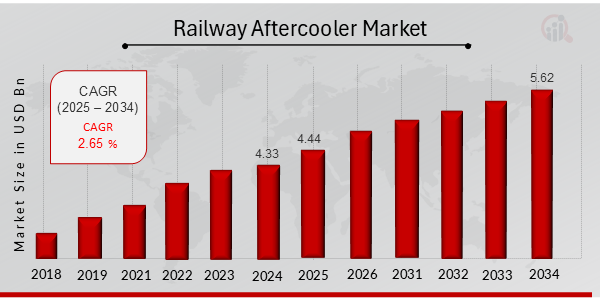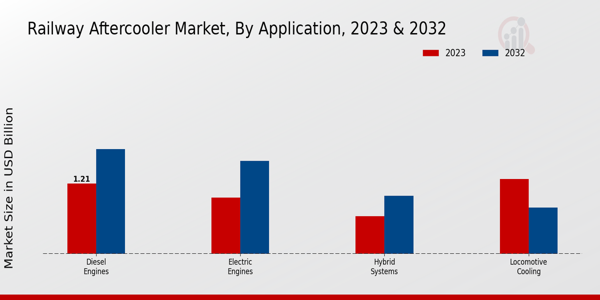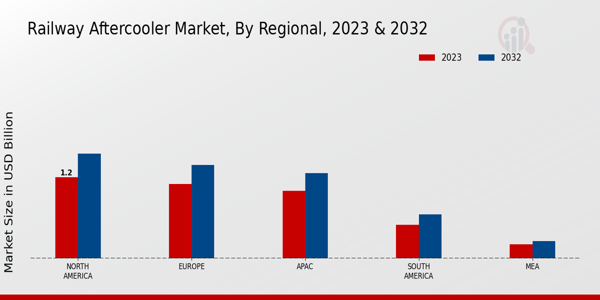Railway Aftercooler Market Overview
As per MRFR analysis, the Railway Aftercooler Market Size was estimated at 4.33 (USD Billion) in 2024. The Railway Aftercooler Market Industry is expected to grow from 4.44 (USD Billion) in 2025 to 5.62 (USD Billion) till 2034, at a CAGR (growth rate) is expected to be around 2.65% during the forecast period (2025 - 2034).
Key Railway Aftercooler Market Trends Highlighted
The Railway Aftercooler Market is experiencing significant growth driven by the rising demand for efficient and reliable train services. Key market drivers include the need for enhanced locomotive performance and regulations focusing on emissions reduction in the transportation sector.
Innovations in aftercooler technology, such as improved heat exchange efficiency and durability, contribute further to market expansion by providing operators with better solutions for managing engine temperatures and preventing overheating.
Opportunities in this market can be explored through advancements in design and materials for aftercoolers, which can lead to increased energy savings and lower maintenance costs. As rail systems look to modernize and integrate green technologies, manufacturers can tap into the growing trend of hybrid and electric trains that require advanced cooling systems.
These shifts in technology present avenues for collaboration and development between equipment manufacturers and railway operators seeking sustainable solutions. Trends in recent times indicate a growing focus on environmental sustainability, prompting stakeholders to invest in energy-efficient solutions, including the aftercooler market.
The increasing prevalence of smart technologies in rail transport allows for enhanced monitoring of aftercooler performance, enabling proactive maintenance and reduced operational disruptions.
Moreover, the global push for interconnected transport systems is leading to the integration of railway services with other modes, thus enhancing overall efficiency and presenting new market opportunities for aftercooler providers.
The shift toward smart rail systems is reshaping the landscape, suggesting a promising future for innovative cooling solutions in the railway industry.

Source Primary Research, Secondary Research, MRFR Database and Analyst Review
Railway Aftercooler Market Drivers
Increasing Demand for Efficient Cooling Solutions
The Railway Aftercooler Market is primarily driven by the rising demand for efficient cooling solutions in railway systems. With the constant growth in railway connectivity and the introduction of high-speed trains, the need for effective cooling systems has become crucial.
Railway engines generate significant heat during operation, and without adequate cooling, performance can be compromised, leading to decreased efficiency and increased operational costs. Aftercoolers play an essential role in reducing the temperature of compressed air before it enters the pneumatic systems, ensuring that the overall railway performance remains optimal.
As the focus on sustainability and energy efficiency intensifies across various industries, the necessity for advanced cooling technologies in railways is becoming increasingly evident.
The shift towards electrified and hybrid trains is expected to further drive the demand for enhanced aftercooling solutions, and manufacturers are likely to invest in innovative technologies that improve thermal performance while minimizing energy consumption.
Additionally, regulatory pressures to meet strict emission standards are pushing railway operators to upgrade their systems, which will significantly boost the market for railway aftercoolers. The expanding railway networks in emerging economies and the modernization of existing systems in developed regions contribute to a healthy growth trajectory for the Railway Aftercooler Market.
Technological Advancements in Aftercooler Designs
Technological advancements in aftercooler designs are fostering robust growth in the Railway Aftercooler Market. Innovations such as compact designs, lightweight materials, and integration with smart monitoring systems are improving the efficiency and reliability of railway cooling mechanisms.
These technological enhancements allow for better heat dissipation and energy savings, thereby attracting operators to upgrade to more sophisticated cooling solutions.
Growing Rail Freight and Passenger Traffic
The continuous increase in rail freight and passenger traffic is significantly driving the Railway Aftercooler Market. As urbanization accelerates and logistics needs evolve, there is a greater demand for efficient rail systems that can handle increased loads.
This surge in traffic necessitates robust cooling systems to ensure the smooth operation of trains, thus amplifying the need for aftercoolers in the railway sector.
Railway Aftercooler Market Segment Insights
Railway Aftercooler Market Application Insights
The application segment of the Railway Aftercooler Market plays a critical role in determining the overall market landscape.
Within this segment, diesel engines dominated significantly, valued at 1.209 USD billion in 2023 and projected to rise to 1.8 USD billion in 2032. This positioning of diesel engines underscored their major role in rail transportation systems, as they offer higher fuel efficiency and reliability in performance, contributing greatly to the Railway Aftercooler Market revenue.
Following closely, electric engines held a value of 0.967 USD billion in 2023, expected to expand to 1.6 USD billion by 2032. The rising demand for cleaner and more sustainable transport solutions propels the growth of this segment, aligning with global trends towards electrification and reducing emissions in the railway industry.
Hybrid systems, with a market valuation of 0.645 USD billion in 2023 and anticipated growth to 1.0 USD billion in 2032, represented an emerging technology that combines traditional propulsion methods with electric solutions, appealing to operators seeking flexibility and efficiency in various operational contexts.
Lastly, the locomotive cooling application was significant in maintaining engine performance, valued at 1.289 USD billion in 2023 but projected to decrease to 0.8 USD billion in 2032, indicating that while essential, it faces challenges tied to advancements in engine technology and thermal management systems.
The diverse application landscape within the Railway Aftercooler Market segmentation highlights the evolving dynamics in the railway sector, featuring traditional and innovative energy systems, each contributing to the overall market growth potential amidst increasing environmental considerations and technological advancements.

Source Primary Research, Secondary Research, MRFR Database and Analyst Review
Railway Aftercooler Market Material Insights
The market encompasses various materials such as aluminum, copper, stainless steel, and plastic, each contributing uniquely to the overall dynamics. Aluminum is defined as a significant portion due to its lightweight properties, enhancing fuel efficiency in railway systems.
Copper is also crucial as it ensures high thermal conductivity, which is critical for aftercooling processes. Stainless steel offers durability and resistance to corrosive environments, highlighting its importance in extending the lifecycle of railway components.
Meanwhile, plastic materials are gaining traction due to their versatility and cost-effectiveness. As railways strive for greater efficiency and sustainability, the material segment reflects these trends, driven by a demand for lighter, more efficient cooling systems.
The growth in these areas contributes to the overall Railway Aftercooler Market revenue, where innovations in material technology continue to propel market growth and adapt to changing industry requirements. The ongoing expansion of the railway infrastructure globally presents numerous opportunities for stakeholders focused on this material segment.
Railway Aftercooler Market End Use Insights
The Railway Aftercooler Market is projected to witness steady growth with an increasing focus on efficient cooling solutions for train operations across various end-use applications. The demand for aftercoolers is primarily driven by the necessity for improved thermal management in locomotives and rail systems.
In the context of end-use categories, freight transport plays a crucial role by ensuring reliable temperature control of engines that handle heavy loads, while passenger transport is significant as it directly impacts travel comfort and safety.
Urban transit systems are also important due to their high ridership, necessitating efficient cooling systems to maintain performance and reliability. Furthermore, the rising popularity and investment in high-speed rail technology contribute to the fundamental need for efficient aftercooling solutions, promoting energy efficiency and operational effectiveness.
Overall, the Railway Aftercooler Market segmentation illustrates the diverse applications and critical nature of aftercoolers across various transport segments, underscoring their relevance in meeting the growing demands of the railway industry.
Railway Aftercooler Market Cooling Type Insights
The Railway Aftercooler Market is experiencing steady growth, driven by the increasing demand for efficient cooling solutions in the railway industry. The cooling type segment plays a crucial role in this market, with various cooling methods such as air-cooled, water-cooled, and oil-cooled systems being employed.
Air-cooled systems have gained considerable traction due to their simplicity and effectiveness in diverse operating conditions, making them a popular choice for rail operators.
Conversely, water-cooled systems are recognized for their superior thermal efficiency, providing critical cooling in high-demand environments, while oil-cooled solutions, although less common, are essential for specific applications requiring high performance and durability.
The diverse Railway Aftercooler Market segmentation illustrates a balanced demand for each cooling type, ensuring that rail operators can select the most appropriate cooling method based on their operational needs.
As the railway industry evolves, the ongoing development and integration of advanced cooling technologies will provide significant opportunities for market growth, supported by an increasing focus on energy efficiency and sustainability.
Railway Aftercooler Market Regional Insights
The North American segment stood out with a valuation of 1.2 USD billion, representing a significant share of the market. Europe followed closely, valued at 1.1 USD billion, characterized by its strong adherence to railway infrastructure improvements.
The APAC region held a valuation of 1.0 USD billion, driven by rapid urbanization and increased investments in railway projects, making it a key player in the market. South America and MEA were valued at 0.5 USD billion and 0.21 USD billion, respectively, demonstrating a growing interest but relatively smaller market share.
The North American region's majority holding was attributed to advanced railway networks and technology prevalence, while APAC's growth is spurred by government initiatives to enhance public transportation. Meanwhile, Europe's emphasis on environmental sustainability and efficiency contributes to its significant position in the Railway Aftercooler Market.
Overall, the regional segmentation showcases diverse growth dynamics influenced by geographical, economic, and infrastructural factors, leading to distinct market opportunities and challenges.

Source Primary Research, Secondary Research, MRFR Database and Analyst Review
Railway Aftercooler Market Key Players and Competitive Insights
The Railway Aftercooler Market is a niche segment within the broader railway and transportation industry that focuses on the provision of aftercooling solutions to enhance the performance and efficiency of railway engines and other systems.
As the demand for efficient powertrain cooling systems continues to rise due to environmental regulations and the need for improved rail transport reliability, the market has begun to see increased competition and innovation.
Key players in this sector are leveraging their engineering capabilities and technological advancements to deliver products that not only comply with stringent regulations but also meet the specific cooling needs of modern railway operations.
The competitive landscape is characterized by a mix of established global companies and innovative startups, each striving to capture market share through strategic partnerships, technological investments, and customer-centric solutions.
Eaton Corporation stands out in the Railway Aftercooler Market due to its extensive experience and proven track record in providing high-quality aftercooling solutions. The company's strong presence in the industrial and transportation sectors delivers significant advantages, particularly in its research and development capabilities that focus on enhancing product efficiency and performance.
Eaton Corporation is recognized for its robust design engineering that accommodates the specific requirements of various rail applications, emphasizing reliability and durability in demanding environments.
Their commitment to sustainability technologies aligns with the global shift towards greener rail systems, enabling them to offer aftermarket solutions that effectively lower emissions and boost operational efficiency. Furthermore, Eaton's extensive distribution network ensures a strong market presence, facilitating timely access to its innovative products and services across different geographic regions.
ABB Ltd has established a solid reputation in the Railway Aftercooler Market through its dedication to innovation and excellence in engineering. The company leverages advanced technologies to develop enhanced aftercooling solutions that cater specifically to the unique challenges faced by modern railway systems.
ABB Ltd is well-regarded for its focus on integration and automation, which enables its cooling solutions to work seamlessly with other railway technologies, thus maximizing system efficiency. The incorporation of digital solutions into their offerings positions ABB as a leader in providing smart and connected cooling systems capable of real-time monitoring and adjustment.
ABB Ltd's strong commitment to research and development, in conjunction with strategic alliances and collaborations, further boosts its market presence and allows it to maintain a competitive edge in delivering high-performance aftercooling solutions for rail applications, meeting the evolving needs of the industry.
Key Companies in the railway aftercooler market Include
- Eaton Corporation
- ABB Ltd
- Alstom SA
- Hitachi Rail
- GE Transportation
- CurtissWright Corporation
- Boge Compressors
- KnorrBremse AG
- Voith GmbH
- Siemens AG
- ThyssenKrupp AG
- Wabtec Corporation
- Bombardier Inc
- Mitsubishi Heavy Industries
- Demag Cranes AG
Railway Aftercooler Market Developments
Recent developments in the Railway Aftercooler Market indicate a significant focus on technological advancements and sustainability initiatives. Companies such as Siemens AG and ABB Ltd are investing in innovative cooling technologies to enhance efficiency in railway operations, reflecting a broader trend towards energy efficiency and reduced emissions.
Additionally, the market is witnessing strong growth as rail networks expand globally, leading to increased demand for after-cooler systems. Hitachi Rail and Alstom SA are actively involved in partnerships to develop next generation aftercooling solutions aimed at improving thermal management in locomotives.
In terms of mergers and acquisitions, GE Transportation's recent acquisition of a precision cooling technology firm is noteworthy, as it is expected to bolster its portfolio in the railway sector. Furthermore, Wabtec Corporation has been ramping up its investments in aftercooler technology to meet the rising need for enhanced performance and reliability.
Overall, these dynamics are reshaping the landscape of the Railway Aftercooler Market, driving both innovation and growth opportunities across industry players such as Eaton Corporation, Knorr-Bremse AG, and Bombardier Inc.
Railway Aftercooler Market Segmentation Insights
- Railway Aftercooler Market Application Outlook
- Diesel Engines
- Electric Engines
- Hybrid Systems
- Locomotive Cooling
- Railway Aftercooler Market Material Outlook
- Aluminum
- Copper
- Stainless Steel
- Plastic
- Railway Aftercooler Market End Use Outlook
- Freight Transport
- Passenger Transport
- Urban Transit
- High-Speed Rail
- Railway Aftercooler Market Cooling Type Outlook
- Air-Cooled
- Water-Cooled
- Oil-Cooled
- Railway Aftercooler Market Regional Outlook
- North America
- Europe
- South America
- Asia Pacific
- Middle East and Africa
| Report Attribute/Metric |
Details |
|
Market Size 2024
|
4.33 (USD Billion)
|
|
Market Size 2025
|
4.44 (USD Billion)
|
|
Market Size 2034
|
5.62 (USD Billion)
|
|
Compound Annual Growth Rate (CAGR)
|
2.65% (2025 - 2034)
|
|
Report Coverage
|
Revenue Forecast, Competitive Landscape, Growth Factors, and Trends
|
|
Base Year
|
2024
|
|
Market Forecast Period
|
2025 - 2034
|
|
Historical Data
|
2019 - 2023
|
| Market Forecast Units |
USD billion |
| Key Companies Profiled |
Eaton Corporation, ABB Ltd, Alstom SA, Hitachi Rail, GE Transportation, CurtissWright Corporation, Boge Compressors, KnorrBremse AG, Voith GmbH, Siemens AG, Thyssenkrupp AG, Wabtec Corporation, Bombardier Inc, Mitsubishi Heavy Industries, Demag Cranes AG |
| Segments Covered |
Application, Material, End Use, Cooling Type, Regional |
| Key Market Opportunities |
Increased rail infrastructure investments, Growing demand for energy efficiency, Adoption of advanced cooling technologies, Expansion of high-speed rail networks, Rising focus on environmental sustainability |
| Key Market Dynamics |
Technological advancements, Growing railway infrastructure investments, Increasing demand for energy efficiency, Stringent emission regulations, Rising focus on sustainable transport solutions |
| Countries Covered |
North America, Europe, APAC, South America, MEA |
Frequently Asked Questions (FAQ) :
The Railway Aftercooler Market is expected to be valued at 5.62 USD billion by 2034.
The projected CAGR for the Railway Aftercooler Market from 2025 to 2034 is 2.65%.
The Diesel Engines application segment is expected to dominate the market, valued at 1.8 USD billion by 2032.
The North American market for Railway Aftercoolers is expected to be valued at 1.55 USD billion by 2032.
The market size for Electric Engines in the railway aftercooler market is expected to reach 1.6 USD billion by 2032.
Key players in the Railway Aftercooler Market include Eaton Corporation, ABB Ltd, Alstom SA, Hitachi Rail, and Siemens AG.
The forecasted market size for Hybrid Systems within the railway aftercooler market is expected to be 1.0 USD billion by 2032.
The Middle East and Africa region is projected to have the smallest market value, estimated at 0.26 USD billion by 2032.
The Locomotive Cooling segment is expected to be valued at 0.8 USD billion by 2032.
The South American market for Railway Aftercoolers is projected to be worth 0.65 USD billion by 2032.

















